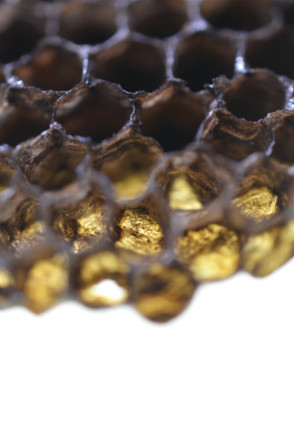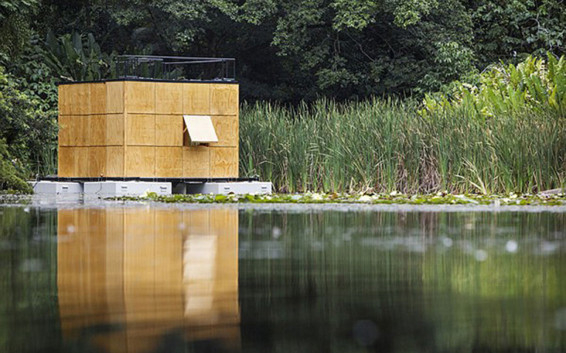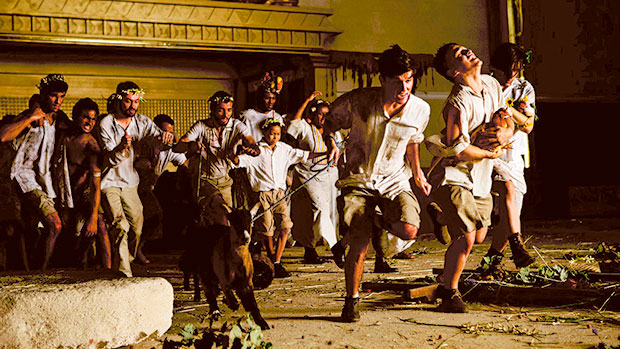
A crowd of VIPs, art lovers and the curious gathered last night beside a lake in the Botanical Gardens that provide a welcome respite from the hurly-burly of the Colombian capital Bogotá.
They were watching a small plywood houseboat float past. The watery, somewhat whimsical installation, is a work by Mateo Lopez, one of Colombia’s better-known artists, and it signalled the opening of ArtBo — Bogotá’s annual art fair today. The amphibious artwork, entitled “Casa Disorientada” (Disorientated House), was inspired by the artist’s trips to the timber mills of Canada and would have helped orientate the eyes of the world towards Colombia’s flourishing art scene.
This is the tenth ArtBo and it has contributions by 66 galleries from 36 countries, many of which will be of special interest to the organisers of Art Dubai, one of the Middle East’s premier events. Art Dubai has recently dispatched a curator to Colombia as part of their plans for a programme of Latin American art at next year’s show.
“We are the focus for art in Bogotá and the country as a whole,” says Maria Paz Gaviria, director of ArtBo, which will last until October 27. “We held our first fair in 2005 with 29 galleries from seven countries. Although it has grown a great deal since then and attracted a great deal of interest we want to keep it a boutique fair, to keep it manageable. In a world of art-fair fatigue where it seems you go and go and go and see the same things over and over and over again as well as the same people, ArtBo is refreshing. What is unique about ArtBo is that we can contribute to the development of the nation’s art scene by showing new talent.”
Outsiders may be surprised to read that Bogotá is staging such an ambitious project. For decades Colombia’s capital — indeed most of the country — was virtually a no-go area, riven by conflict between leftist guerrillas and right-wing paramilitary groups and devastated by the tyranny of the drug cartels. Colombia was, declared its finest writer, the late Gabriel García Márquez, a country consumed by a “biblical holocaust”.
Who would be rash enough to walk the streets of a city where killings and kidnappings were horribly commonplace, let alone visit an art gallery? Indeed, there was scarcely a gallery to visit until a crackdown on the gangs overseen by President Álavro Uribe, who held office from 2002 to 2010, resulted in the murder rate falling from 80 murders per 100,000 residents in 1993 to 17 by 2013.
Bogotá has gone from fear to hope. And to relative prosperity.
The private research firm WealthInsight, which provides information on the very rich, reported last year that the number of millionaires in Colombia had grown by 39 per cent since 2007 to a total of 35,900 at the end of 2012. Evidence of that wealth can be seen in the smart new blocks of flats, fashionable restaurants and shopping malls, though there are policemen and security guards on every corner. The art market is part of that boom, with as many as 40 private galleries opening in the past seven or eight years and with artists winning worldwide recognition. If confirmation of the resurgence was needed, it came from the British publisher Phaidon Press last year when it included Bogotá on a list of ten “Art Cities of the Future”.
As curator Jose Roca, who owns the edgy Flora gallery in the capital, writes in the book: “With no outside intervention, the local scene emerged without the pressures of the market [no production frenzy artificially induced by biennials or galleries]. So when outsiders finally visited they were pleasantly surprised to find a very mature scene with artists that would be major players on the international circuit had they been working in a more connected or more visible environment.”
Bogotá artist Miguel Angel Rojas would agree with that. He insists that apart from the coincidence of money and peace, the interest in Colombian contemporary art is dependent, above all, on its high standard.
Best known for his undercover filming of the forbidden gay scene in the city’s Faenza theatre during the 1970s, Rojas says: “Paradoxically, this high quality is directly related to the intense violence the country lived through for years. The first internationally recognised contemporary Colombian artists were those that responded to this adversity.”
He defines the present art scene in Colombia as “post Fernando Botero”, the hugely popular artist whose bronzes and paintings of voluminous caricatures are worth millions of dollars and seen in many public places and museums.
“For years local collectors were only interested in Botero’s work,” Rojas says. “They did not support more experimental art from Colombia. This is no longer the case.
“There were a handful of visionary gallerists that supported emerging art and encouraged collecting, which changed the art market within the country. There were a few very influential artists who were sensitive to the context and the environment of the Colombian art world and who, in tandem with the development of strong academic and theoretical programmes in some of the universities, have influenced new generations of artists and provided a new conceptual base to the work that is being produced.”
He points out that a great deal of progress has been made in terms of infrastructure, and the organisation of arts from the biennials held in the cities of Cali and coastal city of Cartagena (where the first biennial was held earlier this year). More striking perhaps, in Medellin, a city cursed for years by the malign rule of the drug cartels, a $12 million (Dh44 million) extension to the Museum of Modern Art will open next year as part of the city’s regeneration plans. The Museo de Arte del Banco de la República was opened in 2004 and is an essential component of Bogotá’s art scene with its collection of nearly 5,000 works of Colombian art from the 17th century to the present day.
Some are making a name for themselves on the global stage. Many in the United Kingdom are familiar with Bogotá-born Doris Salcedo because of her installation, “Shibboleth”, which was on show at the Tate Modern’s Turbine Hall in 2007; Britain-based Oscar Murillo impressed London critics with a show at the South London Gallery last year and sold a canvas for £240,000 (Dh1.4 million); the photographer Juan Fernando Herrán was shortlisted for Prix Pictet photography competition for his work “Escalas” set in Medellin, and last week it was announced that he had been given the funding for a year’s project entitled “Consumption” in which he will look at the behaviour of indigenous communities in Colombia.
As Rojas says in answer to a question about the nature of Colombian art: “The new generation of artists has moved away from more overtly political artwork and towards more personal proposals — you might call them more human proposals, art that is more related to form, poetics and the nature of art.
“Either way I believe Colombian art is vital, and having been emboldened by our origins and the information at our disposal, the works speak for themselves. Artists here have developed the confidence to develop their work autonomously.”
Celia Sredni de Birbragher, editor and publisher of Colombia’s Art Nexus magazine, told me earlier this year: “There are many reasons why Colombia is now a destination for the art world. The Nineties were very difficult years for the country and for the art world. I don’t want to go into the details. President Uribe started a programme inviting important people in the news, traders and museum directors to the country and as they came, they saw that the situation had changed and that it was not as bad as the media had covered it from the outside. “Also we have very good artists — that’s the core of the interest,” she said.
Gallery owner Catalina Casas is one of a new breed able to take advantage of her home city’s relative harmony. She owned a gallery in Miami, in the United States, but in 2005 opened Casas Riegner in a fashionable quarter of Bogotá and began to promote the works of the 20 artists on her books to a wider audience.
She says: “The whole security issue, fortunately, has never been something in my life. It always makes the headlines and I’m frustrated when I want to talk about art and it goes more towards the political. Sometimes we make our own mistakes because we try to say how good the country is doing today and to do that we make a lot of references to the past when it was bad. I need to explain how it is in a different way.”
Her most convincing explanation can be found in the list of artists she handles. Apart from Mateo Lopez, who was once chosen to work with South African William Kentridge in the Rolex Mentor and Protégé Arts Initiative, Casas is showing several of her stable at ArtBo, including Bernardo Ortiz, who records the minutia of daily life with detailed drawings; Rosemberg Sandoval, whose works highlight the plight of the poor indigenous people who come to cities to find shelter and work; and Antonio Caro, whose reworking of the Coca Cola logo to read Colombia is a cryptic jibe at the US’s economic muscle — as well as the cocaine trade. Last week Casas showed the flag at London’s Frieze where she sold 12 small drawings by Ortiz to Tate Modern.
Gallerist Nohra Haime, who opened a gallery in New York 37 years ago and recently started another in Cartagena, is also showing at ArtBo.
“It is becoming a destination for people who want to see something different,” she says. Would she have opened her gallery in Cartagena ten years ago? “No way!” she exclaims. “But Colombia has turned the corner. Colombia is flourishing.”
She is showing the videos and sculptures of Cartagena-based Ruby Rumié, some of which looks at injustice and the impact of modernity in the daily lives of common people, and the works of Nicola Bolla, an Italian painter and sculptor who paints animal and human figures with pigment and glitter.
Maria Paz Gaviria, who is the daughter of former president César Gaviria, explains that the fair, which is organised by the Chamber of Commerce, is committed to not just the commercial galleries but to fostering emerging talents.
“The commercial galleries have an international following,” she says. “But there is a new crop of collectors who tend to focus on emerging art. The fair has been central in making that happen and this year, for the first time, a section called Referentes [References] will feature art between 1940-1980. Another section, Artecámera is for the emerging artists under 40 who have no representation but rely on artist-run, independent spaces.”
She adds: “It has become the only significant show for young artists and has grown from showing 23 artists last year to 48. If you look at who has participated in the past two years you’ll find a lot of them are now in the galleries section of the fair. It is really interesting the way lots of galleries and cheerleaders discover a new generation at the fair.”
A themed collection, “Projects”, curated by Jose Roca, shows artists who take inspiration from objects influenced by design.
“I chose 14 artists whose work references industrial, architectural or graphic design and applied arts,” Roca explains. “I also included designers whose work veers towards art in the sense that the objects they design have a strong idiosyncratic presence.”
All this activity has won global interest from the experts — apart from Art Dubai, the Pompidou Centre in Paris has established a Latin American acquisition committee; Moma in New York has appointed a Latin American curator and Jose Roca himself has been given the role of sourcing works for the Tate Modern in London. Next year, Colombian art is to be featured at the International Fair of Contemporary Art in Madrid.
As Mariá Paz Gaviria says, “We are creating a mini Miami here but it’s Bogotá and it’s better.”
Richard Holledge is a writer based in London.















